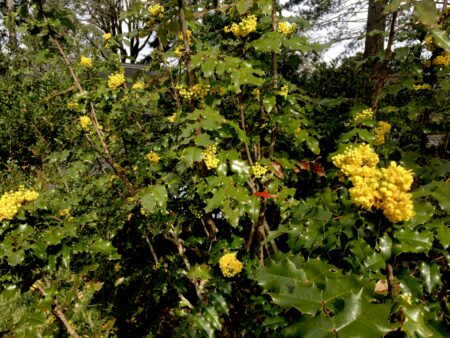Spring Equinox is for You, Mahonia
March 19, 2021
How much time do you spend looking out the window over your kitchen sink? If you’re like me, it’s a daily ritual to gaze out at the world while washing up and preparing food. I wrote in January about the winter display of cedar waxwings descending on tiny rose hips out my kitchen window. Now, nearing the sweet balance of equal day and night that is the Spring Equinox, the foreground of the view has my attention. Planted with room to breathe away from the house (because foundation shrubs are not meant to crowd up on the siding), is our state flower, Mahonia aquifoilum (tall Oregon grape). In the former site of a mud pit for preschool play, we planted a full, bushy, five gallon plant from Doak Creek Native Plant Nursery almost ten years ago.
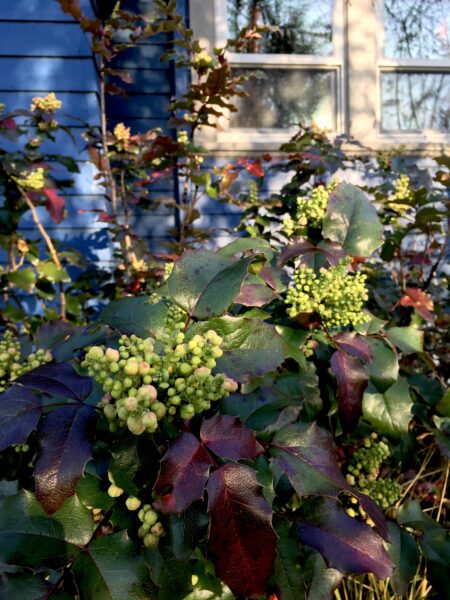
Now, depending on how I shift my weight, I see the clustered yellow buds, kissed peach and on the verge of popping, backed by either vibrant, grassy oranges, bright lemony spears, or muted gray-greens. Orange of Anemanthele lessoniana (New Zealand windgrass) draws out the red of Mahonia’s leaf veins. Lemon yellow of Yucca ‘Gold Sword’ compliments the golden flower buds. The quiet mass of Eleagnus pungens (silverberry) as a backdrop makes me appreciate Mahonia’s rich, forest greens.
Like colors, books, or music, there are plants you love at first sight, those that repel you, and then there are those that you warm up to over time. You may feel more mature as your tastes grow in sophistication.
Tall Oregon grape can be in this last category. Often seen as a long-legged, sparsely foliaged shrub, it’s earned a certain reputation that’s hard to shake. “Rangy” is the most frequent descriptor. That and the prickly leaves can be a turn off at first. But then, one day, maybe it’s today even, on Spring Equinox, you meet a handsome specimen fully clothed in deep glossy green and blooming as bright as a Forsythia. It’s sweet-scented blooms surprise you with a delicate joy. Fat bees, striped black and gold, bumble from cluster to cluster. Now you’re seeing the garden potential of this stylish native.
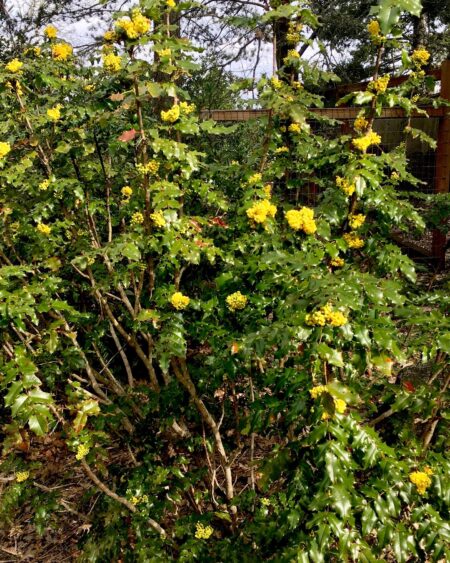
Resources that you rely on to know where to best place a plant lie about Mahonia aquifolium, further perpetuating its “rangy” reputation. If you read that you can plant our state flower in full shade, don’t believe it. I’ve tried. More than once. Not only does it never bloom in shade (so is robbed of it’s purpose), but it also flops on the ground and looks awful, a dog left out in the rain all night, unloved.
Mahonia aquifolium’s happy place: sunshine and (surprise!) fertile soil.
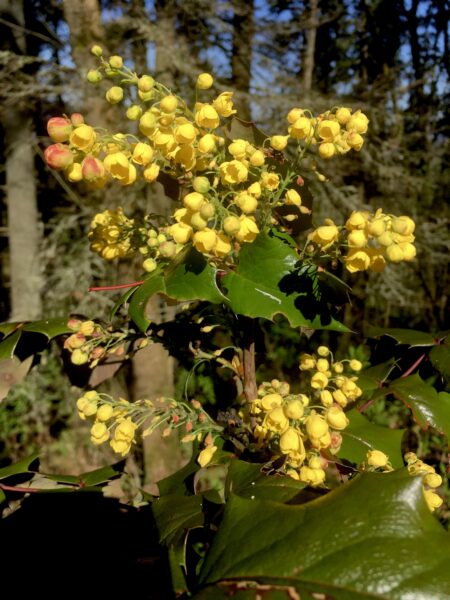
The sun brings plentiful blooms, which means all the activity of native pollinators with abundant powdered blue berries to follow for birds. Sun also does a wonderful trick of turning the evergreen leaves to earthy plums and ripe maroons in the winter. I’ve never seen a Mahonia in the shade perform this magic.
Being native, it’s adaptable to most local soils. Clay or sandy loam both grow great plants around here. But when there’s a naturally richer zone, or if you add a good organic mulch or fertilizer even, tall Oregon grape will grow more foliage and lusher growth. In other words, it will look like a garden plant, an attractive one even out of bloom, rather than a scraggly forest dweller.
Plant Mahonia aquifolium alone as a specimen. Give it a place of Oregon pride. Treat it to annual compost and a post-bloom trimming to a shape round and full. Native Deschampsia caespitosa (tufted hair grass), companionably yellow Narcissus cv. (daffodil cultivars), and boldly ground-covering Geranium macrorrhizum (bigroot geranium) act as support crew in this scene where Mahonia is the star.
*If you garden around deer, take note: all the plants in that little show I just described are stalwarts of deer resistance!*
A mixed hedge is also an excellent way to add a tall Oregon grape to your yard. Sure, you could plant a row of just Mahonia aquifolium four feet apart on center, for a green screen buzzing with life. But, why not mix in a little variety to the hedge? Two different approaches to mixing it up are:
- Choose three species (say Mahonia aquifolium, Philadelphus lewisii, and Cotinus ‘The Velvet Fog’), alternate them five to eight feet apart along the length of your hedge for a regular pattern; or
- Plant three or four Mahonia aq. in a row, then a small deciduous tree (maybe Acer circinatum ‘Pacific Fire’), another Mahonia, a few of another species like Arbutus unedo ‘compacta’ (strawberry bush). Make music, a composition, beauty. Place the plants in your hedge irregularly, but rhythmically: a jazz hedge.
Winter’s end in the mild Pacific Northwest is marked by a slew of flowers happy to bloom even under a light overnight frost. Camellias and daphnes, flowering plums and heathers, crocus and daffodils are some of the reliable classics. I wouldn’t be without daffodils!
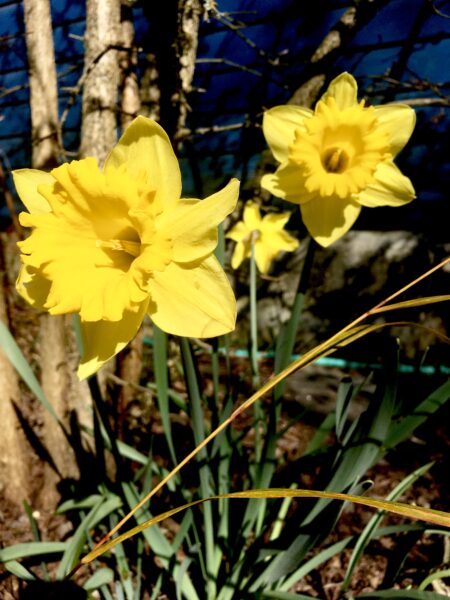
Daffodils gaze from tawny wisps of last year’s grass plumes. Their golden cups fully alert to the season’s awakening. Spring sprouts with a beckoning call to return your hands to the dirt; to putter; to move a plant that languished last year to a new spot – more sun, less crowding; to celebrate; to admire; and to plant more plants!
Give your northwest garden a sense of place and feed native pollinators by planting Mahonia aquifolium (tall Oregon grape) for the Spring Equinox.
